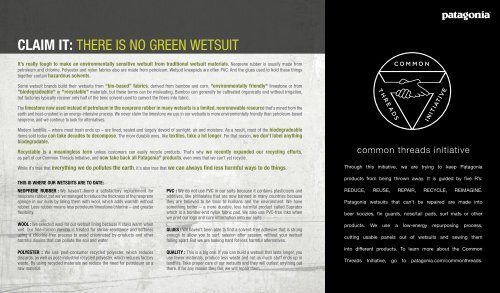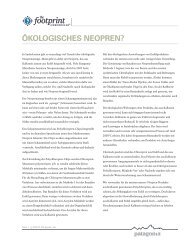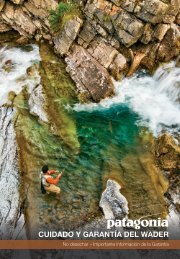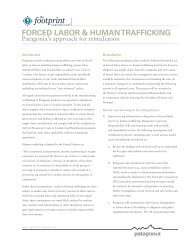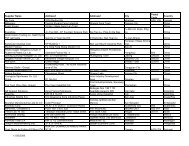Create successful ePaper yourself
Turn your PDF publications into a flip-book with our unique Google optimized e-Paper software.
ClaiM it: There is no green WeTsuiT<br />
it’s really tough to make an environmentally sensitive wetsuit from traditional wetsuit materials. neoprene rubber is usually made from<br />
petroleum and chlorine. polyester and nylon fabrics also are made from petroleum. Wetsuit kneepads are often pVC. and the glues used to hold these things<br />
together contain hazardous solvents.<br />
some wetsuit brands build their <strong>wetsuits</strong> from “bio-based” fabrics, derived from bamboo and corn, "environmentally friendly" limestone or from<br />
"biodegradeable" or "recyclable" materials, but these terms can be misleading. Bamboo can generally be cultivated organically and without irrigation,<br />
but factories typically recover only half of the toxic solvent used to convert the fibers into fabric.<br />
The limestone now used instead of petroleum in the neoprene rubber in many <strong>wetsuits</strong> is a limited, nonrenewable resource that’s mined from the<br />
earth and heat-crushed in an energy-intensive process. We never claim the limestone we use in our <strong>wetsuits</strong> is more environmentally friendly than petroleum-based<br />
neoprene, and we continue to look for alternatives.<br />
modern landfills – where most trash ends up – are lined, sealed and largely devoid of sunlight, air and moisture. as a result, most of the biodegradeable<br />
items sold today can take decades to decompose. The more durable ones, like textiles, take a lot longer. For that reason, we don’t label anything<br />
biodegradable.<br />
recyclable is a meaningless term unless customers can easily recycle products. That’s why we recently expanded our recycling efforts,<br />
as part of our Common Threads initiative, and now take back all <strong>Patagonia</strong> ® products, even ones that we can’t yet recycle.<br />
While it’s true that everything we do pollutes the earth, it’s also true that we can always find less harmful ways to do things.<br />
this is where our <strong>wetsuits</strong> are to date:<br />
neoPrene rubber : We haven’t found a satisfactory replacement for<br />
neoprene rubber, but we’ve managed to reduce the thickness of the neoprene<br />
sponge in our suits by lining them with wool, which adds warmth without<br />
rubber. Less rubber means less petroleum/limestone/chlorine – and greater<br />
flexibility.<br />
wool : We selected wool for our wetsuit lining because it stays warm when<br />
wet. our fine-micron merino is treated for shrink-resistance and softness<br />
using a chlorine-free process to avoid chlorinated by-products and other<br />
harmful dioxins that can pollute the soil and water.<br />
Polyester : We use post-consumer recycled polyester, which reduces<br />
discards, as well as post-industrial recycled polyester, which reduces factory<br />
waste. By using recycled materials we reduce the need for petroleum as a<br />
raw material.<br />
PVC : We do not use pVC in our suits because it contains plasticizers and<br />
additives, like phthalates that are now banned in many countries because<br />
they are believed to be toxic to humans and the environment. We have<br />
something better – a more durable, less harmful product called supratex<br />
which is a bomber-knit nylon fabric pad. We also use pVC-free inks when<br />
we print our logo and care information onto our suits.<br />
glues : We haven’t been able to find a solvent-free adhesive that is strong<br />
enough to allow you to surf, session after session, without your wetsuit<br />
falling apart. But we are looking hard for less harmful alternatives.<br />
Quality : This is a big one. if you can build a wetsuit that lasts longer, you<br />
use fewer materials, produce less waste and not as much stuff ends up in<br />
landfills. Take proper care of our <strong>wetsuits</strong> and they will outlast anything out<br />
there. if for any reason they fail, we will repair them.<br />
common threads initiative<br />
through this initiative, we are trying to keep <strong>Patagonia</strong><br />
products from being thrown away. it is guided by five r’s:<br />
reduce, reuse, rePair, recycle, reimaGine.<br />
<strong>Patagonia</strong> <strong>wetsuits</strong> that can’t be repaired are made into<br />
beer koozies, fin guards, nose/tail pads, surf mats or other<br />
products. We use a low-energy repurposing process,<br />
cutting usable panels out of <strong>wetsuits</strong> and sewing them<br />
into different products. to learn more about the common<br />
threads initiative, go to patagonia.com/commonthreads.


